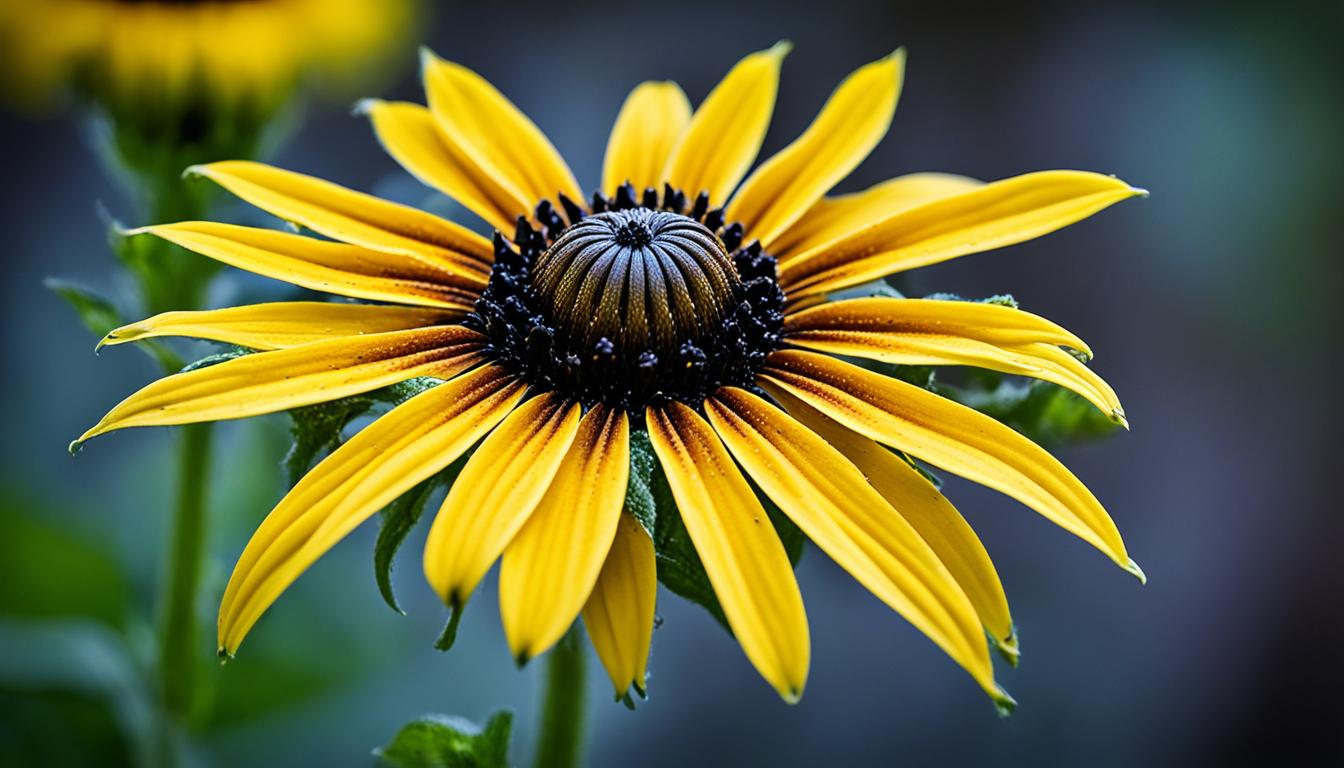Harvesting black eyed Susan seeds is a rewarding way to grow these beautiful wildflowers. These plants, part of the Rudbeckia genus, brighten any garden with their cheerful blooms. I’ll share how to collect and save black eyed Susan seeds, so you can enjoy them for years.
Timing is crucial for harvesting black eyed Susan seeds. The seed heads must be dry and brown before you collect them. After picking the right plants, follow simple steps to separate the seeds from the chaff. Then, store them properly for future planting.
What are Black Eyed Susans?
Black Eyed Susans, also known as Rudbeckia, are a beloved type of wildflower found in North America. They are known for their bright yellow petals and a dark brown or black center. These flowers are a favorite among gardeners and nature lovers because of their vibrant colors and long-lasting blooms.
Identifying True Native Species
The true species of native black eyed susans is Rudbeckia hirta. This perennial flower has hairy stems, rough leaves, and a black-brown center. Rudbeckia hirta is often grown as an annual in colder climates.
Difference Between Hybrids and Cultivars
While native black eyed susans are beautiful, there are also many rudbeckia cultivars and rudbeckia hybrids available. These varieties can have bigger flowers, brighter colors, or grow more compactly. It’s important to know how to identify black eyed susans to understand their differences. The seeds from these varieties may not be the same as the parent plant.
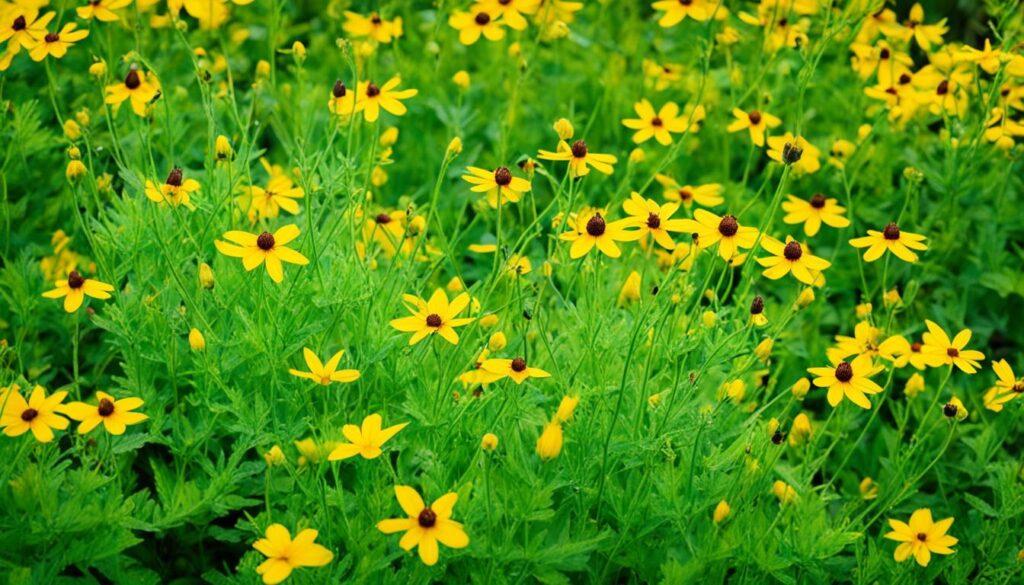
“Rudbeckias can be planted in spring after the soil warms or in fall in mild winter climates.”
| Characteristic | Native Rudbeckia hirta | Rudbeckia Hybrids/Cultivars |
|---|---|---|
| Hardiness | Tender perennial, often grown as annual | Varying hardiness depending on cultivar |
| Flower Size | Smaller, typical 2-3 inch diameter | May have larger flowers, up to 6 inches |
| Petal Color | Bright yellow | Can include different shades of yellow, orange, or even red |
| Seed Viability | Highly viable, can self-seed | Varies, may not produce viable seeds |
When to Harvest Black Eyed Susan Seeds?
Harvesting black eyed susan seeds at the right time is crucial for success. This process removes almost all chaff, leaving you with pure live seed. But, the Rudbeckia seed heads are harder to open than most, making the harvest a bit tricky.
Usually, black eyed susan seeds are ready to harvest three to four weeks after the flower blooms. Most seeds are ready from mid-September to mid-October. This is when the seed heads turn brown and dry out.
Make sure the seed heads are completely dry before you harvest the seeds. This step ensures the seeds are as viable as possible. Black eyed susan seeds can last for a few years, but their quality drops a bit each year. Keeping them stored properly is key to keeping them fresh.
By saving black eyed susan seeds, you can grow many plants from one. One plant can produce over 1000 seeds in a season. This is much cheaper than buying plants from a garden center, which can cost $10-$20 each.
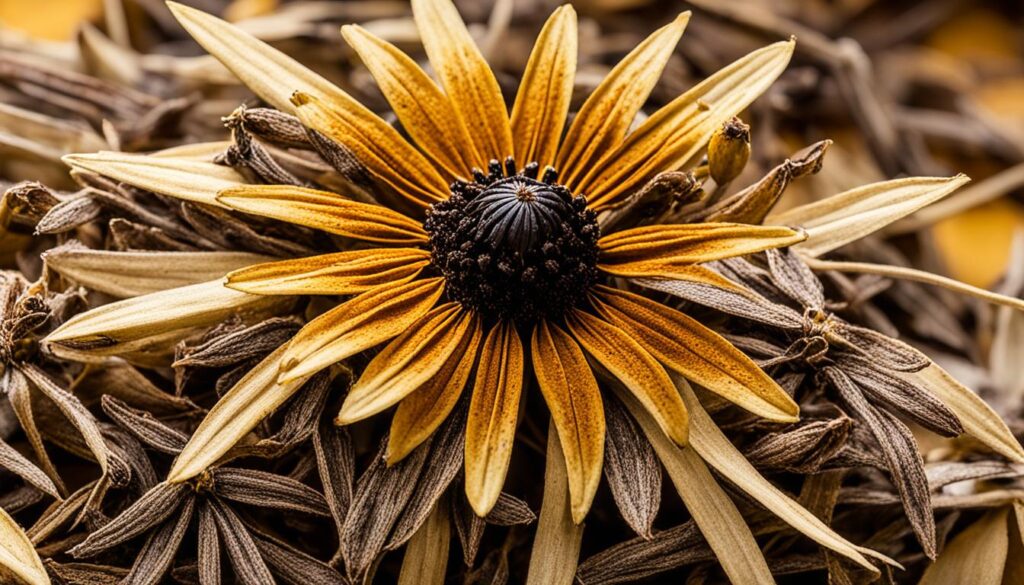
However, saving seeds from hybrid black eyed susan plants might not give you the best results. They might not produce the same flowers or could be sterile. For the best outcome, use seeds from the native black eyed susan species.
How to Harvest Black Eyed Susan Seeds?
Harvesting Black Eyed Susan seeds is rewarding and can save money. It also helps spread these lovely flowers. The secret to getting pure seeds is to separate the chaff from the seeds. I’ll share a simple method that ensures nearly 100% live seeds.
Separating Chaff from Seeds
Black Eyed Susan seed heads mix seeds with chaff, making it hard to get the seeds alone. Start by gently shaking the seed heads in a container. This drops most of the chaff, leaving the seeds at the bottom.
For better results, try the “secret shaking method.” Put the seed heads in a container with small, heavy things like bolts or rocks. Shake it hard for a few minutes. This dislodges any leftover chaff, giving you pure Black Eyed Susan seeds.
The Secret Shaking Method
To use the secret shaking method, just follow these steps:
- Gather your Black Eyed Susan seed heads and put them in a strong container, like a mason jar or a plastic box.
- Add some small, heavy things like bolts or rocks to the container.
- Shake the container hard for 2-3 minutes, making sure to shake all the seed heads.
- Take out the seed heads, leaving the chaff and heavy objects behind.
- If needed, shake again to get all the seeds separated.
This easy method gets rid of the chaff, letting you collect a lot of pure, usable Black Eyed Susan seeds.
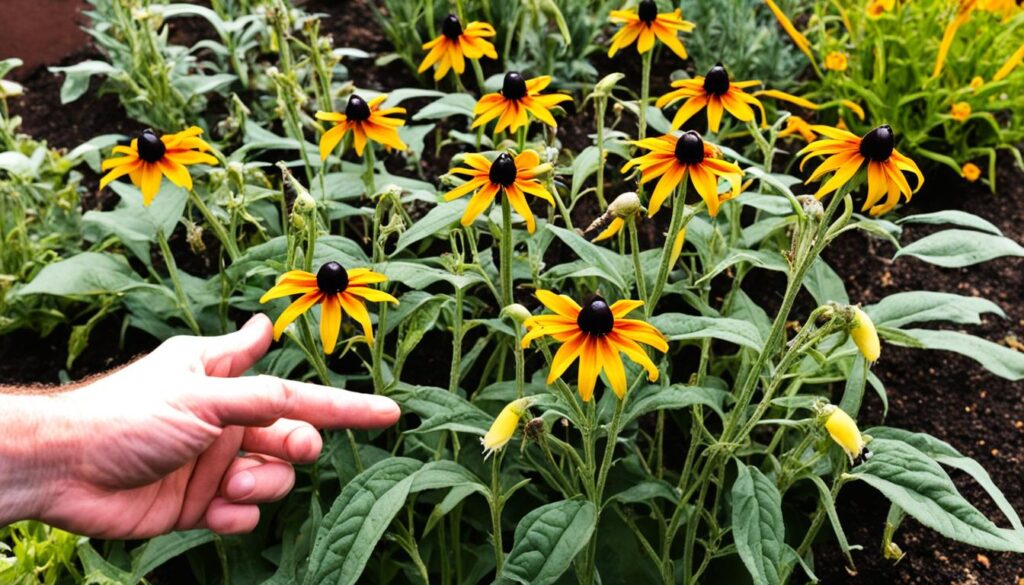
Storing Black Eyed Susan Seeds
Keeping your Black Eyed Susan seeds viable is crucial for successful growth. Whether you gathered them from your garden or the wild, the right storage methods are essential. They help keep the seeds ready for planting in the future.
Seed Viability and Storage Tips
For Rudbeckia hirta (Black Eyed Susan) seeds, store them in a glass jar with a tight seal. Keep it in the fridge. This keeps them fresh until the next growing season, whether in spring or fall.
Seed maturity is marked when the nutlets turn charcoal-gray, about 3-4 weeks after blooming. Harvest the seeds when the cones open up. This shows they are fully mature and ready for use.
To boost germination, try stratifying the seeds for 3 months at 40 degrees Fahrenheit before planting. This cold treatment mimics winter and can help seeds sprout better.
| Storage Tip | Benefit |
|---|---|
| Store in a sealed glass jar | Maintains seed viability |
| Refrigerate at 40°F | Preserves seed quality |
| Stratify for 3 months | Enhances germination |
By using these easy storage and prep tips, you can keep your Black Eyed Susan seeds viable. They’ll be ready for planting when the time comes.
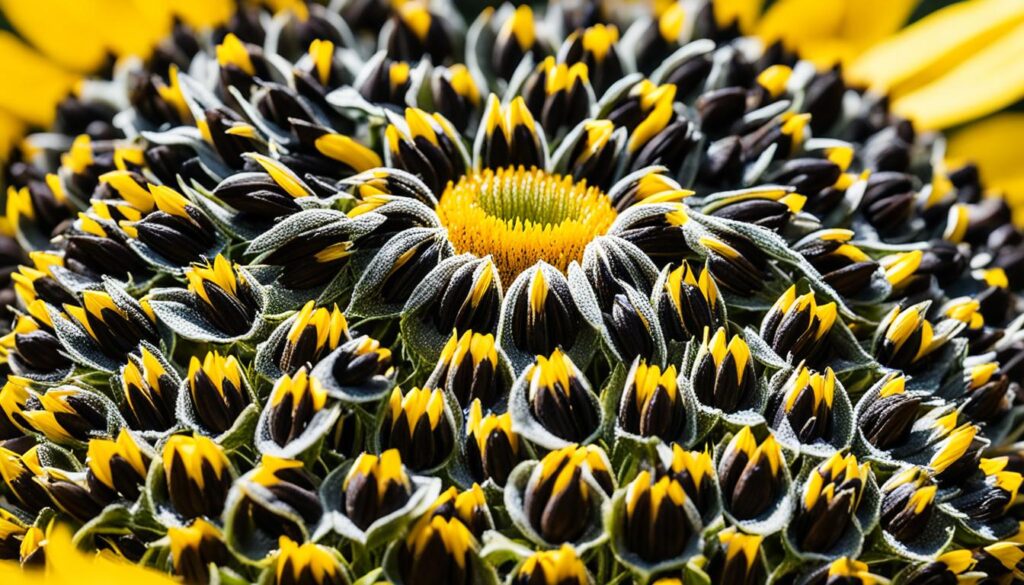
“Storing Black Eyed Susan seeds properly is the key to maintaining their viability and ensuring a successful crop year after year.”
Why Save Your Own Seeds?
Saving your own black eyed susan seeds is a great way to grow more of these lovely wildflowers for free. A single black eyed susan plant can produce up to 1,000 seeds. This means you can easily grow black eyed susans from saved seeds and propagate black eyed susans from saved seeds. By doing this, you ensure you’re growing plants that fit well in your local area, unlike hybrid or store-bought ones.
One major benefit of saving black eyed susan seeds is saving money. Buying new seeds every year can get expensive. But by harvesting and storing your own, you’ll have seeds for free. Plus, you’ll know exactly where your plants came from and how they were grown.
Saving black eyed susan seeds lets you pick for the traits you like, like brighter colors or longer blooms. Over time, you can make a special strain of black eyed susans that fit your garden perfectly. This can make your garden more diverse and tough, needing less care.
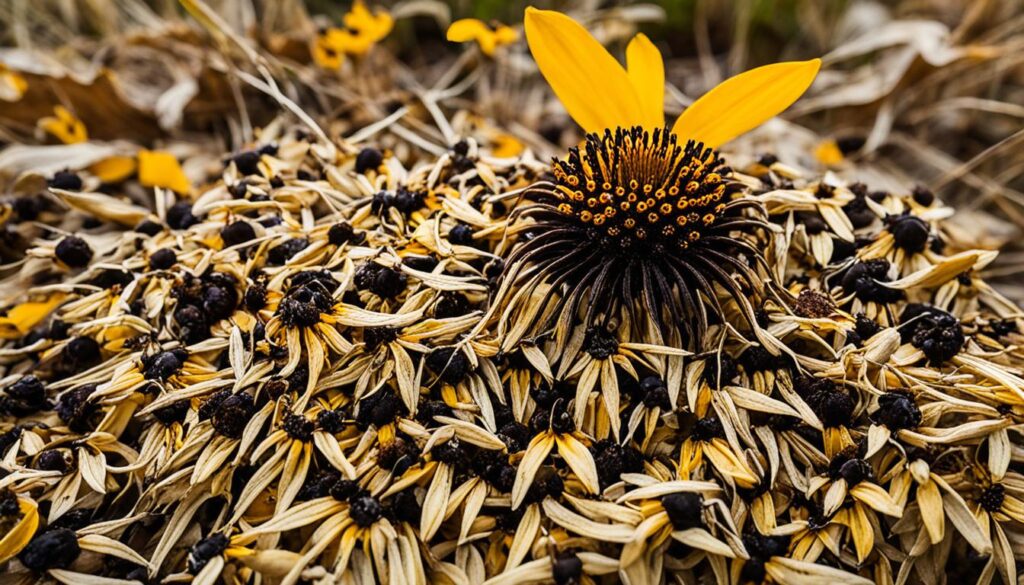
If you want to grow black eyed susans from saved seeds and propagate black eyed susans from saved seeds, start saving your own black eyed susan seeds. It’s easy and rewarding, bringing benefits for many years.
Conclusion
Harvesting black eyed susan seed is easy and rewarding. It lets you grow more of these beautiful flowers for little to no cost. This guide shows you how to identify the plants, collect and process the black eyed susan seeds, and store them properly. This way, you’ll have a steady supply of seeds for your garden every year.
Whether you’re new to gardening or have been doing it for years, growing black eyed susans from seed is a great choice. These flowers are tough, easy to care for, and bloom for a long time. They add color and beauty to your garden. So, collect those black eyed susan seeds and start growing your own patch of these lovely flowers.
With a bit of time and effort, you’ll have lots of these happy flowers in your garden. They’ll make your garden look beautiful and bring joy for many seasons. Enjoy your black eyed susan seed harvesting!
FAQ
What are Black Eyed Susans?
Black Eyed Susans, also known as Rudbeckia, are native wildflowers in North America. They can be identified by their look. Hybrids and cultivars might look different.
How do I identify true native Black Eyed Susan species?
Make sure to correctly identify the Black Eyed Susan type before harvesting seeds. Seeds from hybrids and cultivars might not grow well or could produce different flowers.
When is the best time to harvest Black Eyed Susan seeds?
Harvest Black Eyed Susan seeds a few weeks after the flowers bloom and the seed heads dry out. This is usually a month after they start blooming.
How do I harvest Black Eyed Susan seeds?
Harvesting Black Eyed Susan seeds requires removing the chaff from the seed heads. Shake the seed heads in a container to get rid of most chaff. Then, use small, heavy objects to shake the seed heads again and separate the seeds from any leftover chaff.
What is the “secret shaking method” for harvesting Black Eyed Susan seeds?
The “secret shaking method” uses small, heavy objects to shake the seed heads. This gets nearly 100% live seeds out of the seed heads.
How should I store Black Eyed Susan seeds?
Store Black Eyed Susan seeds in a cool, dry place to keep them viable. Use plastic containers, jars, or paper envelopes. They can last several years, but planting them soon after harvest is best to keep germination rates high.
Why should I save my own Black Eyed Susan seeds?
Saving your own Black Eyed Susan seeds lets you grow more of these beautiful wildflowers for free. One plant can give you up to 1,000 seeds. This way, you grow plants that fit your local environment well, unlike hybrids or cultivars.
